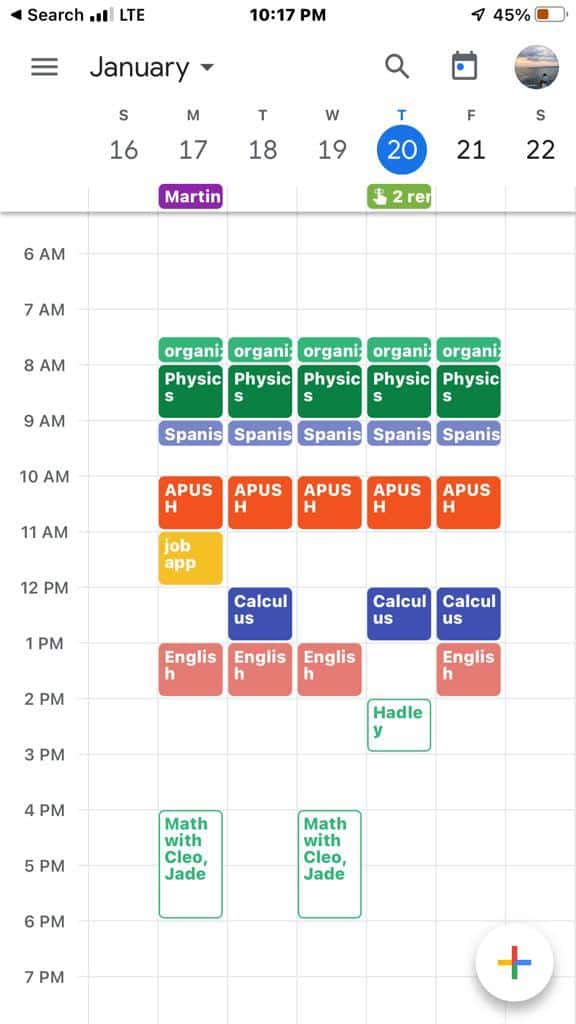As a homeschooler or worldschooler you (and your parents) face a distinct challenge: What skills and habits will enable me to be a successful self directed learner?
In traditional school a lot of organization, time management, and study skills learning is done for you. You move through the same class schedule every day. There are teachers and school administrators to nag you about assignments and grades. Although every family organizes their homeschool environment differently, in general homeschoolers need to be much more self-starting, organized, and proactive about school than our peers in brick and mortar schools. We have to perfect the art of self directed learning.
The following self directed learning methods and tips are designed to help you succeed with your Cicero courses, other non-traditional school courses, and in life generally.
Proactive Time Management for Self Directed Study
In a traditional school environment your time is mostly managed for you You get a schedule handed to you. Heck, in a lot of schools a bell rings to move you from one place to another. This doesn’t exist in a self directed learning environment like Cicero or eclectic homeschooling. To be an effective student you need to build a structure for yourself. This is how self directed learning in the classroom – and out of it – benefits your studies.
There are a lot of methods for time management, most of which involve scheduling your time on a calendar. The most common strategies we’ve seen Cicero students adopt are time-blocking and the Pomodoro technique—and, often, a combo of the two. As a self directed learner, you create and hone the time management skills that best suit your needs and learning style.
Self directed homeschooling relies heavily on creating and curating a schedule that works for students, families, and learning styles alike. Time-blocking is simple. You simply schedule blocks of time on your calendar for each subject you’re studying. So, for example, you might allot one hour each day for each subject. Here’s how one Cicero student, Cleo, does it.

Note, on Cleo’s calendar “Hadley” is her once weekly meeting with her English teacher via Cicero and “Math with Cleo and Jade” is her math class with Cicero.
Here’s another example in which the student allots 50 minutes to each subject, giving him 10 minutes of “reset time” between classes if they are back to back. Also, notice how this self directed learner includes his non-academic regular activities like soccer, dance, and a hoped-for surf on Sundays:

Notice, too, how the student has taken his due dates—an English paper due on Wednesday and a chemistry test on Thursday—and added them in sharp red with exclamation alerts. This isn’t time-blocking, but rather an example of syllabus management, which we’ll discuss below.
One last thing about this self directed learner’s schedule to notice is how he elects to take Friday off. He does this by scheduling things more heavily Mon-Thu and added a light morning school session on Saturday. This is similar to how a lot of European school schedules look. In any case, this is one of the great things about self-directed learning: If you take a proactive approach to time management you create time for yourself to “do something cool.”
Pomodoro is similar to time-blocking, but the blocks are longer (90 minutes) with 5-minute breaks between each 25-minute chunk of work time. Pomodoro enthusiasts often download a Pomodoro timer like Pomofocus.io. A number of Cicero students use Pomodoro in their self directed learning method and swear by it.
It’s smart to treat time management itself as a subject to be studied. You can read more in this excellent review of time management tips from Asana.
Becoming a Master (not Slave) of Time With Self Directed Study
You should be a master of your calendar, not its slave. Laying out your schedule with 50-minute blocks for each subject is a framework for how you plan to execute your day and week. However, realize that sometimes you will enter a flow state with a subject or project, in which case it’s better to continue with that and move your blocks around. For example, let’s say you have math work scheduled for a 50 minute block from 10-10:50. You plan for a 10-minute break, and then to switch to Latin at 11am. However, you get into a flow with math and find that you’re really cooking at 10:50. It may be better to continue after a quick (maybe just 5 minutes) break, and push your Latin to the next day—meaning you’ll probably spend close to 2 hours on Latin tomorrow.
Reaching flow state with your work is great thing. Read more about it from this great post at Asana.
Proactive Course/Syllabus/Teacher Management
We often learn in traditional school that the teacher and school are the boss. They tell us what to do. As a result, as students we take a passive stance, waiting for instruction.
This doesn’t work with self-directed learning. If you’re passive and waiting you’ll miss stuff like assignments and due dates. You’ll get poor grades. But, more importantly, you’ll miss key skills and knowledge, which will come back to haunt you later in your career as a student.
To be a successful self directed homeschooler, you should lean-in and be proactive with your course. Do you have the syllabus? You should, and you should have all the due dates, meeting times, and assignments in your calendar.
You should also be proactive with your teacher. Don’t wait for her to explain something or tell you more about an assignment. Reach out with your questions. This is what email is for.
A good habit to get into for self directed study is to take five minutes at the end of each live session to understand your work for the coming week. Are there deliverables due—i.e. something like a paper, project, or exam prep that you have to deliver? Have a quick conversation with your teacher to go over this.
Another great habit is to take another fifteen minutes directly after class to capture any assignments in a to-do list for the week and to double check that you understand your assignments. If you don’t, email your teacher ASAP.
Capturing Work & To Do Lists
The concept of “capturing” your assignments is a powerful one. Think about that word. When you capture something you quell it and tame it. If you’ve ever felt overwhelmed and stressed by all that you have to do, capturing that mass of obligations in a well-structured to-do list can be liberating and help you relax a bit in your self directed studies. A captured obligation is less haunting.
A to-do list is essential for any effective work strategy – especially for self directed homeschooling – and there are a number of different ways to organize your list and technologies for managing it. One approach is to have a to-do list with categories or sections devoted to each subject so that you can turn just to that section of the list when it’s time to work on that subject and ignore everything else. The objective here is to gainin a given subject, and part of that clarity is achieved by blocking everything else out. It should be evident how a structured, categorized to-do list aligns with a time-blocking strategy.
Another key attribute of a to-do list is that you can check off or strike out items as you complete them. A lot of people swear by a simple notebook for to-do lists. Others love tech, and there are a number of really good apps for to-dos. Todoist and Asana are probably the simplest and easiest. Notion and Evernote combine to-do lists with a lot of other features.
For what it’s worth, the administrators of Cicero use Todoist for our task list and Evernote as our writing, filing, and note-taking.
Self Directed Learners: Masters of Tech
We live in a technological world, and chances are that your schooling sits on a tech stack. A lot of Cicero teachers use Google Classroom; some math teachers use Google Jamboard. You should be a master of these tools and be on top of your tech to perfect the art of self directed learning. There’s always a learning curve when you have to adopt a new technology. But, not everyone’s learning curve is as long, and you can do things to shorten yours. You can get good at learning new technology by doing things like mastering the art of the video tutorial. For example, a Cicero student recently wanted to learn how to use Figma in order to make a prototype for a physics class. She signed up for a 3.5-hour Figma basics class on Udemy for $15, and in short time was producing amazing, professional-grade prototypes.
Think of this skill—the ability to learn a new tech—as future-proofing yourself.
Some other, specific, tech hacks to help you excel at self directed learning:
- Be a calendaring whiz. Be sure that every appointment is your calendar, that you’ve invited everyone who needs to attend, and that you’ve loaded up the video call login details so no one has to email you annoyingly to ask “when are we meeting?” or “are we using Zoom?” This stuff should be in the calendar event. Done. Check out Mashable’s tips for calendar management.
- Headphones. You should have a good pair of headphones and use them for any online meeting so that the other person can hear you clearly instead of a lot of background noise. Yes, super expensive conference call or gaming headphones are great; but even a $10 set of earbuds is a million times better than nothing at all.
- Email zero. Yes, email is an ancient technology used by dinosaurs and your parents. But, it’s still primarily how the world communicates, and folds well into your collection of self directed learning methods and tools. Chances are that any assignments, meetings, or other information from the various classes that you’re taking will come to you via email. You need to be a master of email. Learn how to clear your inbox with things like the Inbox Zero Method or by using things Boomerang or Gmail’s native reminder system.
Have a View on Your Self Directed Workload
In Cicero, your teacher will often ask you for your view on your work. For example, how much reading do you want to do this week? You should have an opinion on this and have a view on what’s working and what’s challenging. You are a co-author of your learning.
This isn’t an opportunity to slack and try to reduce your workload, since by doing so you’re only cheating yourself. It’s about taking full responsibility for your self directed learning along with your parents, teachers, and any others who may be involved, and making sound decisions.
Life Hacks for Self Directed Study
A big part of being productive in school or work or just life in general derives from being healthy and well rested. Here are some things to think about:
- Sleep. Yes, your parents are right. You need sleep. A lot of it. This is when your brain does most of its growing. More sleep makes you better able to process, which makes self directed learning easier. It’s that simple.
- Exercise. There’s a ton of research between exercise and brain health. One thing exercise does is make your brain more plastic, and hence better able to learn. Note how the calendar example above has a daily workout scheduled.
- Diet. You are what you eat. Put junk in, get junk out. If you’re a snacker—and in your teens you should probably be snacking quite a bit, especially if you’re active—set yourself up with healthy brain snacks like almonds and dates and apples.
Work on Work
Lastly, take your work organization as seriously as you take the work itself, especially if you plan to master self directed studies. You should spend some time working on your set up, from time management to note taking, and constantly hone it. A good place to start is Hank and John’s Green’s Crash Course, which has a good section on Study Skills.
By investing in this early and often you’ll make the ultimate work that you produce better, and you’ll make your own life more fun and manageable.
Heck, you might even get to do something cool every Friday.







